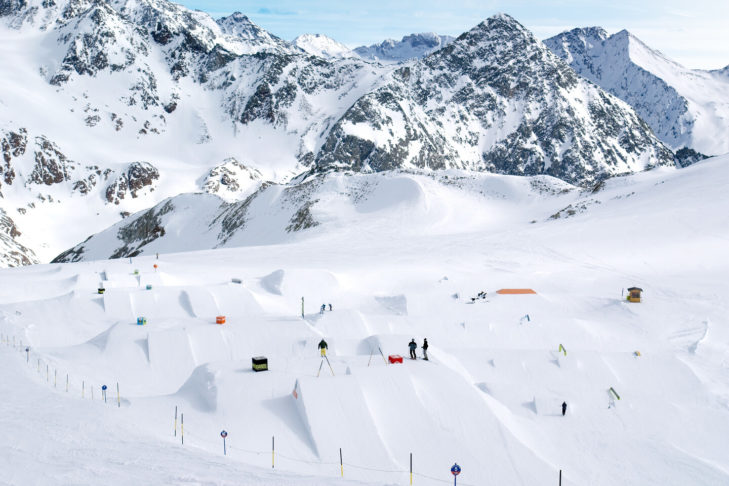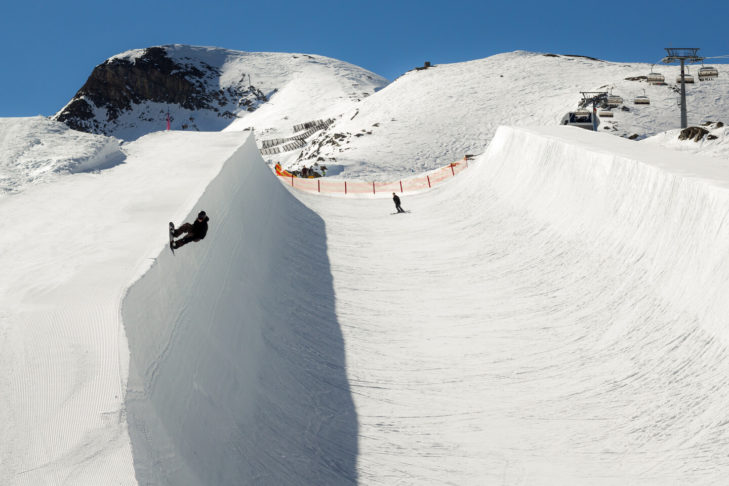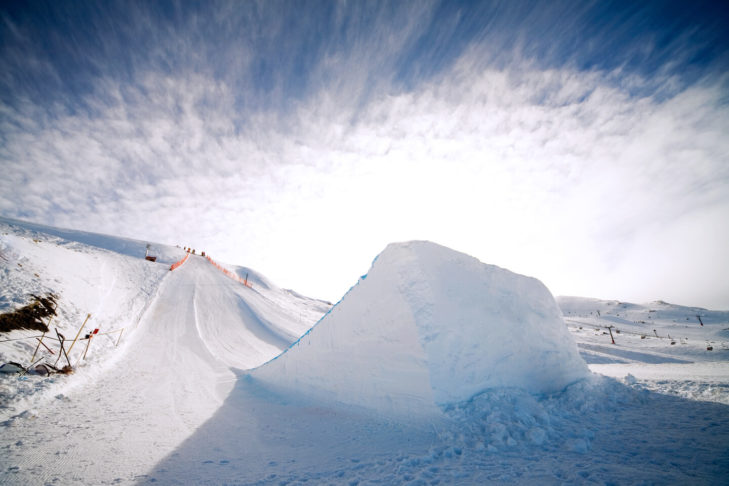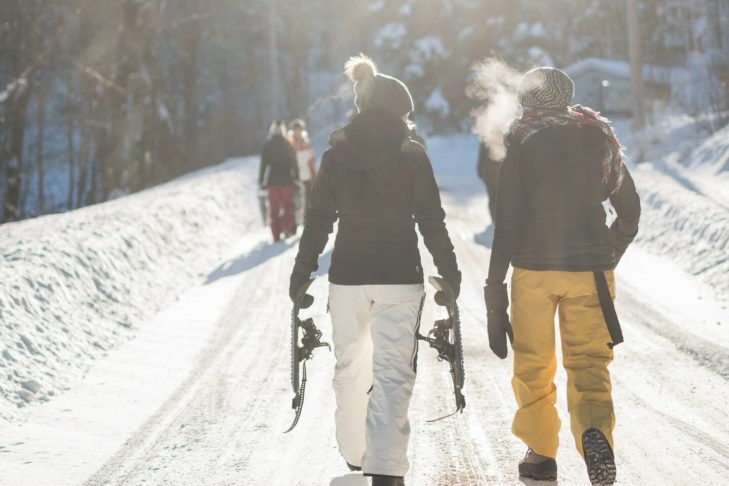Grabs, flips, turns, slides – these are terms that come from the skateboarding scene, describing various tricks that skateboarders perform on their boards. But since the end of the 1980s, these terms have also become familiar in winter sports. In so-called fun parks or snow parks, winter sports enthusiasts, like skateboarders, can perform tricks on special courses. Fun parks can be found in almost every ski resort and add another fun element to winter sports. SnowTrex provides tips and tricks about fun parks in winter sports.
Fun parks offer fun and thrills
Fun parks are special leisure parks in winter sports resorts where skiers and snowboarders can perform tricks such as jumps, spins or flips that are too dangerous on normal pistes.
Even though the tricks and obstacles in fun parks are part of freestyle skiing, the exercises in fun parks are different from ski cross. Ski cross is an Olympic discipline in which four skiers ski simultaneously on a course with jumps, waves and curves. Fun parks, on the other hand, do not follow the same rules, have different elements and are intended for those who want to try something different in winter sports.
Such fun parks are relatively new in winter sports. The first improvised freestyle parks appeared in the USA in the 1960s. The first official fun parks date back to the 1980s and owe their origin to the growing popularity of snowboarding. Snowboarders were quick to try to incorporate jumps into their downhill runs, similar to skateboarding. The first fun parks were therefore specifically designed for snowboarders, which is why the elements of fun parks even today are still very similar to skateboarding elements.
Fun parks can now also be found in almost every ski resort in the Alps. They give winter sports enthusiasts the opportunity to try out different tricks and techniques, they are popular with children and provide a little more thrill when skiing. This is why they attract a different audience than the classic pistes. The fun parks were also intended to give the Alpine region a more modern image.
However, the facilities have been criticised: In order to build the fun parks, increasingly remote areas are being developed, which jeopardises nature. On the other hand, the proximity to nature also makes winter sports enthusiasts more aware of and sensitive to the issue of the environment and nature conservation. Some ski resorts are making a compromise and building the fun parks closer to the valley so that sensitive natural areas are spared and fewer emissions are produced during the construction of the parks.
Please also note that by using our services and integrating the YouTube API Services, the YouTube Terms of Service and the YouTube API Services Terms apply and your use of our website is deemed to be acceptance of these terms.
From beginner to pro: the different levels of difficulty in fun parks
As with regular ski slopes, there are also different levels of difficulty in fun parks:
The lines, as the slopes are called here, range from beginner to pro level. There is no standardised naming system, so you should find out about the terminology for each fun park in advance.
- Lines for beginners only have small jumps with a low level of difficulty. They are called beginner lines or small lines (S-lines).
- More advanced beginners ride on lines that allow medium to large jumps and have a medium level of difficulty. These are called medium lines or fun lines.
- Sometimes there is also a “medium-high” gradation. These lines lie between the experienced-beginner and advanced levels.
- The lines for advanced skiers are called large lines (L) or extra-large lines (XL), depending on the level of difficulty. They can also be called advanced lines, pro lines or progression lines.
- Some fun parks also offer special lines for families with children. These are called family lines.
From jibs to kickers: the different obstacles in fun parks
The different obstacles in the fun park can be divided into four main categories: Jibs, jumps, pipes and kickers. There are also very specialised elements such as hips, spines or urban features.
Jibs
As with skateboarding, jibs are elongated fixtures of different lengths and widths that are set up either perpendicular or parallel to the snow surface. Various tricks can be performed on these surfaces, such as spins or backwards descents. The most well-known jibs include, for example, rails, boxes, tabletops and wall rides.
Rails are a narrow, rounded or flat metal surface on which you can slide (known as “jibbing”).
The boxes are inspired by the fun boxes used in skateboarding and are similar to rails, only they have a wider surface. They are usually not made of metal, but of synthetic man-made fibre.
Wall rides are almost vertical, wall-like constructions.
Tabletops are like rails, only even wider, and are therefore ideal for beginners who are not yet confident on boxes or rails. They often initiate jumps, which is why they are also described as jump obstacles.
Jumps
Jumps involve performing a variety of leaps using different setups.
The tabletop is particularly popular for jumps: This element is not only used for gliding, but also for jumping. With the tabletop, you glide from the top onto a flat surface and jump from there onto a lower descent. Step-down means that you also land further down from a higher starting point. However, there is no flat surface as with the tabletop. A step-up uses the reverse principle: here you jump from a lower starting point to a higher landing surface. Gaps are also popular and feature a gap between take-off and landing so that you can perform various tricks in flight.
Pipes
A distinction is made between half-pipes and quarter-pipes. The half-pipes are shaped like a “U” and have wide surfaces at both upper ends on which you can land, so-called lips. Quarter pipes are designed vertically so that you can jump from the lip upright into the air, perform tricks here and finally land on the same lip again.
Kickers
Kickers are ski jumps, often levelled out of snow with snow groomers. From here, you jump into the air and can do many tricks, from flips to spins, stretches or even holding on to your skis (grabs). There are no rules as to how high or steep the kickers can be built. They often have a long inrun track so that high speeds can be reached. You should therefore be particularly careful here.
Riding on rails, boxes and kickers: tips and tricks
Of the elements mentioned, rails, boxes and kickers are among the most popular obstacles in fun parks. They are so popular because they allow a variety of figures and tricks and are therefore suitable for both beginners and advanced riders. However, riding on rails, boxes and kickers requires some practice.
How do you ride rails and boxes?
As rails are narrower than boxes, most beginners start with the boxes. However, the skiing technique is very similar: with rails, you have to pay more attention to the position of the skis due to the narrower surface. One ski is flat on the rail, the other controls the side. If you realise that you are falling, simply go with the movement and let yourself fall sideways off the rail. This way you land in the snow and avoid a hard fall onto the rail.
The approach should be like the run on the piste. You should place your weight in the centre of the skis and lean slightly in order to be particularly stable. It is important not to keep your speed too low, otherwise you will not make it to the end of the rail or box. Too high a speed, on the other hand, can easily throw you off balance and you won’t be able to perform your tricks at all. It therefore takes some trial and error to find the right speed. During the run-up, it helps to repeat the trick you want to do out loud to yourself so that you are mentally well prepared to glide onto the rail or box. The landing, in turn, is slow and soft.
Typical mistakes with rails and boxes are holding your skis too close together and moving your arms too much. Both can quickly lead to you losing your balance and falling. The distance between the skis should therefore not be too close and the arms should remain as still as possible.
Please also note that by using our services and integrating the YouTube API Services, the YouTube Terms of Service and the YouTube API Services Terms apply and your use of our website is deemed to be acceptance of these terms.
How to master kickers
The biggest challenge with kickers is getting the necessary momentum. Theoretically, you just jump up into the air, but as you can’t move your lower legs well due to the bindings and also have to lift the weight of your skis and ski boots into the air, it’s much more strenuous than a normal jump.
The approach is done in a bend in order to gain as much momentum as possible on the take-off. Hips and knees are bent, the upper body keeps the balance by being positioned in the centre over the skis.
There are two techniques for jumping, “jumping” and “the ollie”. When jumping, the power comes from the thighs; when doing an ollie, the tips of the skis are pulled upwards. This gives you more lift and a longer flight time, but is not as balanced and smooth as jumping. It is therefore more suitable for experienced jumpers.
In addition to lift, timing is also crucial. If you jump too early, you won’t get very high or very far. If you jump off too late, you will get far, but not high enough to do tricks in the air. The ideal time is therefore exactly when you reach the lip of the kicker.
In the air, pull your feet in slightly and lean forwards a little. This reduces air resistance and maintains your balance. This also gives you more distance, which you need for a soft and safe landing.
Just before landing, the body is lengthened to take the speed and power out of the landing. You should not stretch out completely straight, as it is too easy to fall over when landing on the snow. As soon as you touch the snow, bend your knees very low. This keeps you straight and absorbs the impact well. Your skis land flat on the ground and your upper body is tilted forwards. Once you have landed safely, you slowly straighten up again.
Please also note that by using our services and integrating the YouTube API Services, the YouTube Terms of Service and the YouTube API Services Terms apply and your use of our website is deemed to be acceptance of these terms.
Safety first
Turns, jumps, figures in the air – as you can already see from the above descriptions, riding in fun parks requires a high level of concentration and acrobatics. As the obstacles are usually ridden at high speeds and the lines are also often full, the topic of “safety” is very important in fun parks.
This includes having the right equipment: a helmet, ski goggles and protectors. A protector for the back is important for keeping your back safe in case you fall.
However, as with piste skiing, equipment is not everything. It is also necessary to ski carefully and considerately in the fun park. Correct behaviour is therefore also part of the safety regulations. Anyone riding in the fun park should therefore observe the park rules. These include:
- Always show consideration for others.
- Make sure the lane is clear before setting off.
- Do not jump the queue.
- Do not enter the lane from the side.
- Give a hand signal before setting off.
- The run-up distance and time must be carefully planned for the kicker. If you are unsure, you can orientate yourself on other jumpers.
- Clear the run-out track quickly after the run.
- Always adjust the speed and difficulty of the line to your own ability.
If you keep this in mind and are fit, careful and considerate when skiing, you will get your money’s worth in the fun parks.
Fun parks are standard in almost all ski resorts. They offer more thrills for the adventurous and the opportunity for the curious to try out different skiing and snowboarding techniques. If you protect yourself with the right protective equipment, respect the park rules and don’t overdo things, you are guaranteed to have a lot of fun in the fun parks.
FAQ’s on fun parks
What is a fun park?
Fun parks are special leisure areas in winter sports resorts where skiers and snowboarders can perform tricks such as jumps or spins – similar to skateboarding.
What is the difference between a fun park and skicross?
While fun parks are an offer for winter sports enthusiasts and the courses do not follow any specific rules, freestyle skiing in ski cross has other elements and is an Olympic discipline.
Which obstacles can be found in the fun park?
The four most common categories of obstacles are jumps, jibs, kickers and pipes, each of which enables different tricks such as jumps, glides and spins.
Are the lines in fun parks categorised according to difficulty?
Yes, just like on regular ski slopes, the lines in fun parks also have different levels of difficulty. They are either categorised in ascending order from S to XL or according to their level from beginner to medium to progression / pro lines (advanced).
What safety equipment do you need for fun parks?
In addition to helmets and ski goggles, protectors are important, especially for the back, to protect against falls. But it’s not just the equipment that ensures greater safety, winter sports enthusiasts in the fun park should also adhere to the park rules and the general rules of behaviour and ski with consideration and adapt their speed to their ability.









